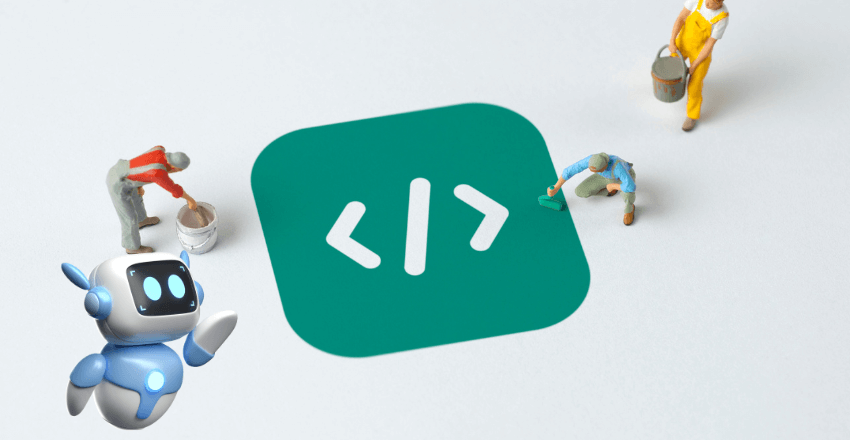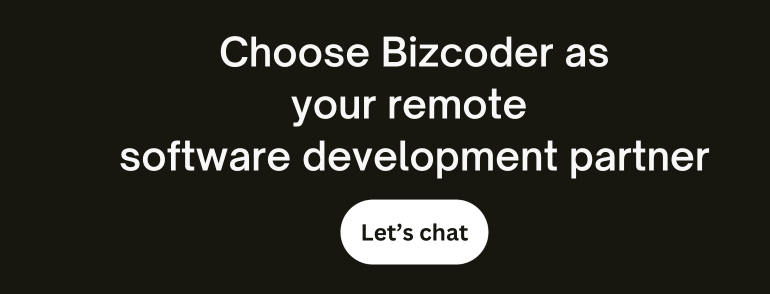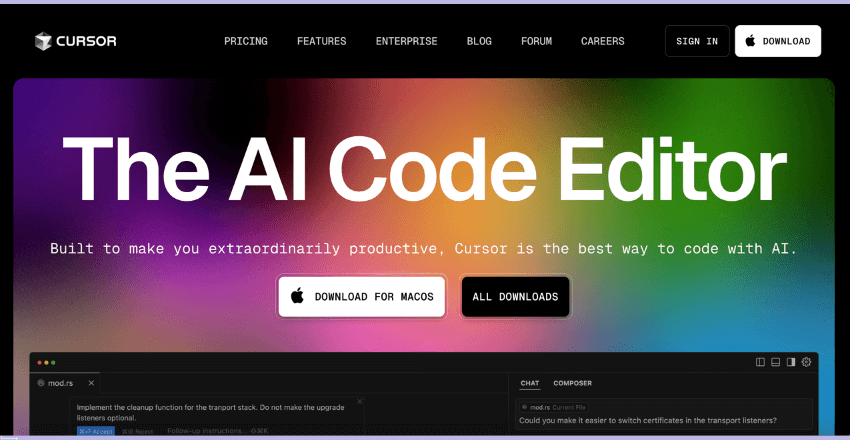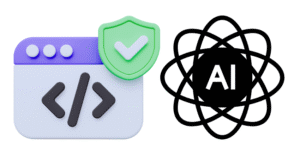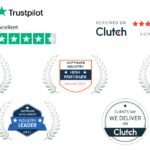No-code and AI tools are reshaping business landscapes by enabling rapid application development and data-driven automation without extensive coding skills. From streamlining workflows to enhancing customer experiences, the combination of no-code platforms and AI offers powerful, cost-effective solutions for businesses of all sizes.
No-Code & Low-Code Platforms: What Each Tool Does Best (Bubble, Nowa, Make.com, Backendless)
The no-code and low-code movement has exploded, and with good reason. You don’t have to be a developer to bring a tech idea to life anymore. Whether you’re a solopreneur building your first app, a small business automating workflows, or a startup spinning up full-scale platforms, there’s a tool designed just for your use case.
1. Bubble: Full-Stack Web Apps Without Code

If you’ve got a vision for a fully functioning app, think Airbnb, Twitter, or your next startup idea, Bubble is where to start. It’s a visual web app builder that lets you drag, drop, and design your entire application from frontend to backend, no code required.
What it’s best for:
Building full-stack web applications
Designing responsive UI with pixel-level control
Setting up backend logic (like user authentication, payments, workflows)
Connecting APIs and third-party services
Why people love it: Bubble gives you serious freedom. It’s not limited to templates, you can build completely custom functionality. Think of it as a visual coding platform that feels like designing a PowerPoint, but with database power and business logic underneath.
2. Nowa: Next-Gen App Development

Nowa is a newer player but brings some fresh energy to the no-code scene. Unlike some tools that just do one part of the job, Nowa focuses on cross-platform mobile app development, aiming to give you more control without diving deep into traditional coding.
What it’s best for:
Building mobile apps (iOS & Android)
Real-time testing with device previews
Incorporating logic with a drag-and-drop interface
Generating clean Flutter code for developers who want to go hybrid
Why people love it: Nowa bridges the gap between no-code simplicity and dev-level flexibility. It’s especially useful if you plan to hand off your app to a developer later, because it outputs actual code.
3. Make.com: Visual Automation for Everything

Need to automate tasks, connect services, and build out backend workflows visually? That’s Make. It’s like a mix between Zapier and a lightweight backend builder, with a super visual interface that makes it easy to create and scale automations.
What it’s best for:
Automating business workflows (e.g., syncing data between apps)
Integrating multiple tools without writing code
Triggering logic based on data events
Orchestrating backend processes (think: a form submission triggers a Slack message + updates a CRM + emails the user)
Why people love it: Make is the go-to for visual workflow automation. You see the whole process play out in a flowchart-like interface. If you don’t need a full-blown app but want backend muscle behind your systems, Make is your tool.
4. Backendless: The Brains Behind Your App
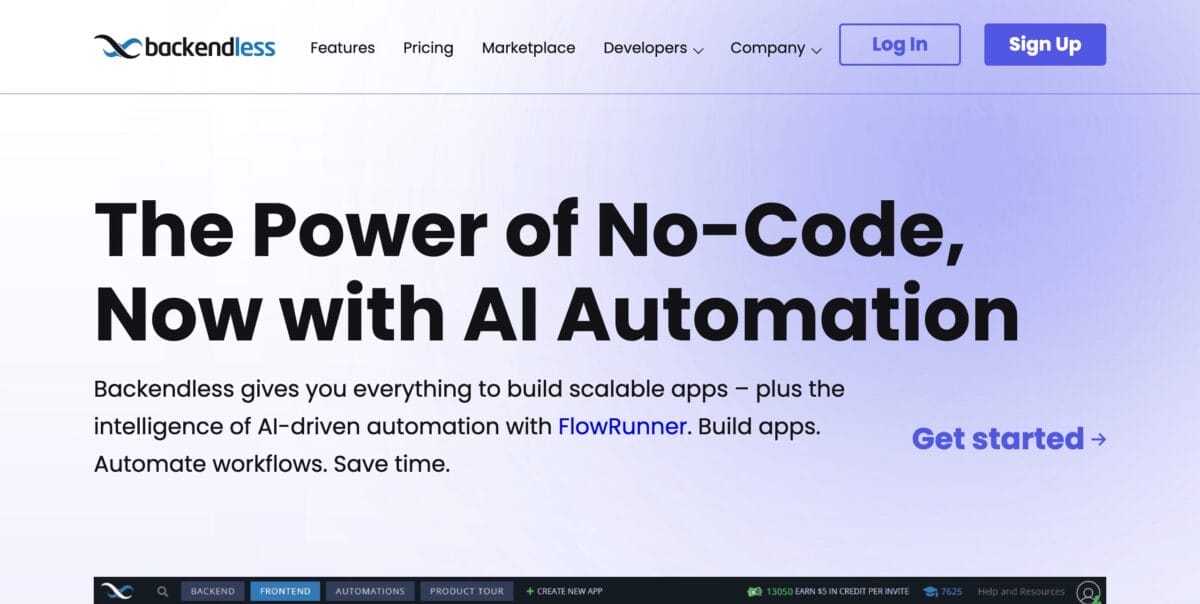
If Bubble is the whole car, Backendless is the engine. It focuses on the backend: data storage, APIs, user auth, real-time messaging, and server-side logic, all with a visual interface that keeps things beginner-friendly but powerful.
What it’s best for:
Creating scalable backend infrastructure for mobile or web apps
Managing a real-time database without writing server code
Using Codeless logic for complex workflows and app behavior
Setting up API services to connect your app to external tools
Why people love it: Backendless handles the stuff you don’t see, logic, databases, cloud storage, so your frontend (built in something like Nowa or Bubble) can shine. It’s ideal when you’re working with other tools and need a strong backend to plug into them.
Tool Comparison: Who Does What Best?
Here’s a quick look at how they stack up:
| Tool | Type | Best Use Case | Backend Logic | Frontend Design | API Integrations | Mobile Support |
|---|---|---|---|---|---|---|
| Bubble | Full-stack no-code builder | Full web apps with custom UI and workflows | Yes | Yes | Yes | Via wrappers |
| Nowa | Mobile-first builder | Cross-platform mobile apps | Basic (visual) | Yes | Limited | Native |
| Make | Automation platform | Workflow automation and backend processes | Yes (visual) | No | Yes | No |
| Backendless | Backend-as-a-Service | App backends, real-time databases, API creation | Yes (Codeless) | No | Yes | Via integration |
No matter what you’re building, be it a slick mobile app, a fully customized web app, or just an automated workflow to save your sanity, there’s a no-code or low-code tool that fits your needs. Use:
Bubble when you want full control of a web app from frontend to backend.
Nowa when your focus is native mobile apps with room to grow into dev territory.
Make when you need powerful automations and integrations with little friction.
Backendless when you want a visual backend builder to power and scale your app logic.
They’re all different slices of the same pie, and sometimes, using two or more together is exactly what gets the job done.
Why Combine No-Code and AI?

1. Accelerate Digital Transformation
Traditionally, building applications required skilled developers and significant resources. No-code platforms eliminate these barriers by providing intuitive interfaces, drag-and-drop functionality, and pre-built templates. Integrating AI further enhances these platforms by automating data processing, decision-making, and customer interactions.
Example: A retail business can use a no-code platform like Bubble to create a customer feedback app, integrating AI tools like MonkeyLearn to analyze sentiment and identify trends in real-time.
2. Reduce Operational Costs
Developing software in-house or outsourcing to developers is costly. No-code platforms reduce costs by enabling non-technical staff to build and manage applications independently. AI-driven automation further reduces labor costs by taking over repetitive tasks.
Case Study:
Company: An e-commerce store
Challenge: High customer support costs
Solution: Implementing Landbot, a no-code chatbot platform, with ChatGPT for AI-powered customer service.
Result: 60% reduction in customer service costs, 24/7 support availability.
3. Faster Time to Market
Traditional app development can take months or even years. No-code platforms expedite this process by using templates and pre-built modules. AI tools automate complex processes, reducing project timelines further.
Example: A fintech startup uses Webflow to build a landing page in hours and integrates DataRobot to provide predictive analytics for lead scoring, launching in just two weeks.
4. Scalability and Flexibility
No-code platforms are inherently scalable, allowing businesses to add new features, workflows, or integrations without starting from scratch. AI tools enhance scalability by automating data processing, enabling rapid adaptation to changing business needs.
Tools to Consider:
Make (formerly Integromat) – Automate workflows and connect multiple apps.
Zapier – Automate repetitive tasks and data transfer between apps.
Airtable – Manage data and integrate AI analytics seamlessly.
How to Implement No-Code and AI in Your Business
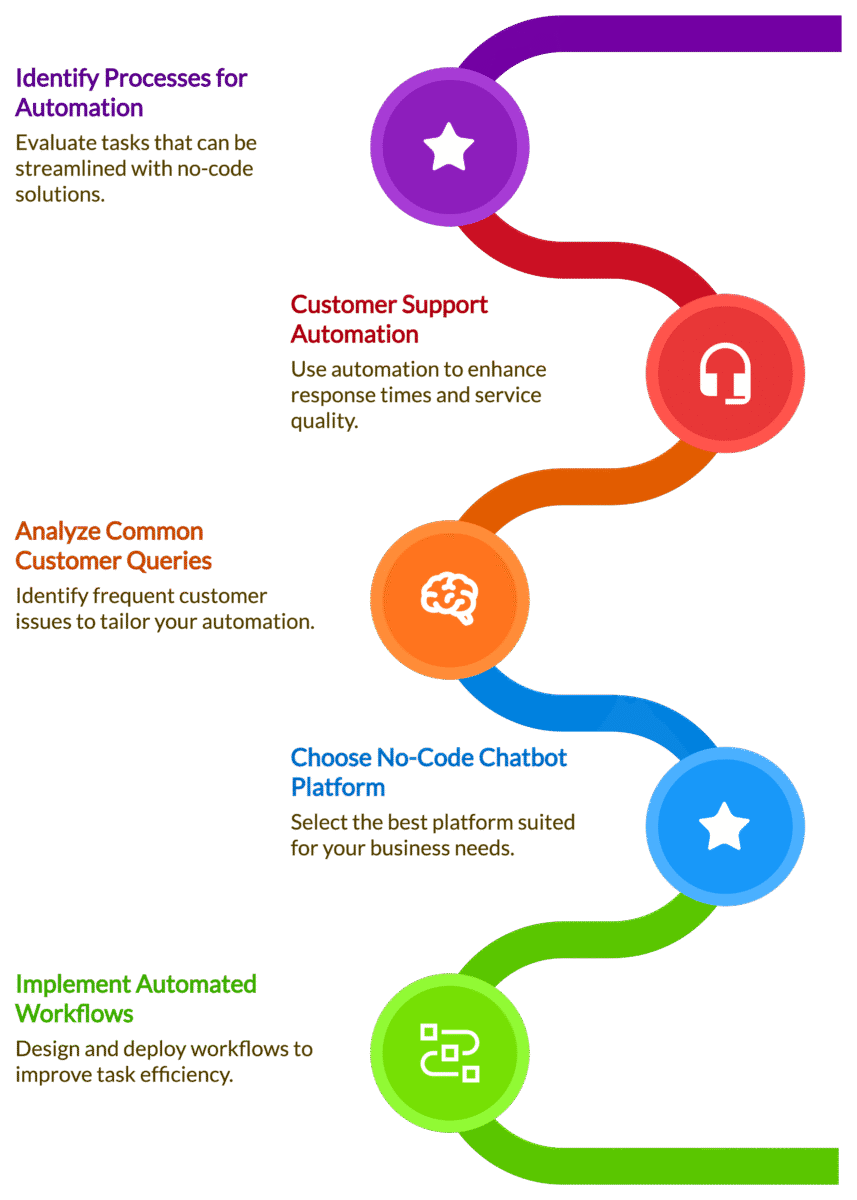
Step 1: Identify Processes for Automation
Before diving into no-code and AI implementation, the first critical step is identifying the processes within your business that are ripe for automation. The key is to pinpoint repetitive, time-consuming, or error-prone tasks that can be streamlined using AI-powered no-code tools. This strategic analysis will not only improve operational efficiency but also reduce costs and free up employees for higher-value tasks.
1. Customer Support Automation: Enhancing Efficiency and Responsiveness
Customer support is often one of the most resource-intensive areas in any business. Automating routine interactions using AI chatbots can significantly reduce response times and enhance customer satisfaction. Here’s how to implement it effectively:
a. Analyze Common Customer Queries
Identify Repetitive Inquiries: Review your customer support logs to identify the most common questions. These are typically FAQs such as product pricing, shipping status, return policies, and technical troubleshooting.
Segment Inquiries by Complexity: Not all queries can be handled by AI. Segment them into simple, repetitive questions that can be addressed by a chatbot and complex queries that require human intervention.
b. Choose the Right No-Code Chatbot Platform
Landbot: Offers drag-and-drop chatbot building and AI integration. Ideal for handling FAQs and routing complex inquiries.
ManyChat: Integrates with social media platforms, allowing you to automate responses across Facebook, WhatsApp, and Instagram.
ChatGPT: Advanced conversational AI that can handle more nuanced customer interactions and escalate issues when necessary.
c. Implement Automated Workflows
FAQ Automation: Develop a decision tree to categorize customer queries and provide instant responses using pre-written scripts.
Ticket Routing: Automate ticket generation and routing using tools like Freshdesk. Assign complex queries to human agents based on keywords or urgency.
Post-Interaction Follow-Up: Set up automated follow-up messages to gauge customer satisfaction and collect feedback.
Example Use Case:
A SaaS company uses Landbot to automate 60% of customer support inquiries. Simple queries like password resets and pricing information are handled by AI, while complex technical issues are escalated to human agents. This reduces support response times by 40% and improves customer satisfaction scores by 30%.
2. Data Analysis Automation: Streamlining Data Processing and Reporting
Data analysis is another area where automation can deliver significant returns. Manual data entry, report generation, and data analysis are not only time-consuming but also prone to human error. AI-powered no-code tools can automate these tasks, providing faster and more accurate insights.
a. Identify Data-Intensive Processes
Data Entry and Integration: Inventory updates, CRM data entry, and sales data aggregation are common repetitive tasks that can be automated.
Data Analysis and Reporting: Identifying sales trends, customer behavior, and performance metrics through data-driven reports.
Data Cleanup and Standardization: Ensuring data integrity by removing duplicates, correcting errors, and standardizing formats.
b. Choose the Right No-Code Data Automation Tools
Airtable: Combines database management with AI analytics. Ideal for data entry and reporting automation.
Zapier: Connects multiple apps to automate data transfers, such as syncing CRM data with marketing platforms.
Make (formerly Integromat): Provides advanced automation scenarios for data processing, reporting, and visualization.
c. Automate Data Analysis and Reporting
Data Collection: Automate data entry from various sources (e.g., e-commerce platforms, CRM systems) into a centralized database using Airtable or Zapier.
Data Processing: Use AI tools like MonkeyLearn to analyze text data for sentiment analysis or trend identification.
Report Generation: Set up automated report generation using Google Data Studio or Zoho Analytics. Customize dashboards to provide real-time data visualization.
Example Use Case:
A retail chain integrates Airtable with Make to automatically pull sales data from multiple stores into a single dashboard. AI algorithms analyze the data to identify top-selling products, seasonal trends, and underperforming locations. As a result, data processing time is reduced by 70% and inventory management becomes more accurate.
3. Marketing Automation: Personalizing and Scaling Campaigns

Marketing departments are increasingly relying on AI to segment audiences, personalize content, and automate entire campaigns. By leveraging AI and no-code tools, businesses can enhance their marketing strategies without increasing manpower.
a. Identify Marketing Tasks for Automation
Email Campaigns: Automate welcome sequences, cart abandonment emails, and promotional offers based on user behavior.
Content Personalization: Use AI to recommend products, content, or services based on user preferences.
Audience Segmentation: Automatically segment leads based on demographics, engagement, and purchase history.
b. Select the Right No-Code Marketing Automation Platforms
Mailchimp: Email marketing with AI-driven audience segmentation and content recommendations.
HubSpot: CRM integration, email automation, and lead scoring powered by AI.
Jasper: AI content generation for personalized email copy, blog posts, and social media content.
c. Implement Marketing Automation Workflows
Lead Nurturing: Develop automated email sequences using Mailchimp to guide leads through the sales funnel.
Content Distribution: Use Jasper to generate email content and connect it with Mailchimp for automatic distribution.
Audience Segmentation: Employ HubSpot’s AI to score leads based on website behavior, email engagement, and CRM data.
Example Use Case:
A digital marketing agency leverages HubSpot to automate its email marketing campaigns. AI analyzes lead behavior to trigger personalized email sequences for each segment. By integrating Jasper, the agency automates content generation, increasing email open rates by 35% and reducing campaign management time by 50%.
Key Takeaways for Identifying Processes for Automation
Focus on repetitive, time-consuming tasks that consume significant resources or are prone to human error.
Start small by automating simple, well-defined tasks, then scale to more complex workflows.
Choose tools that can integrate seamlessly with your existing tech stack to avoid data silos.
Prioritize processes that directly impact customer experience, data accuracy, or revenue generation.
Identifying and automating these core processes sets the foundation for successful no-code and AI integration. Once you’ve mapped out key workflows for automation, the next step is selecting the right platforms and implementing AI-enhanced workflows to maximize efficiency and ROI.
Tool Recommendations:
Landbot – AI chatbots for customer support.
MonkeyLearn – Text analysis and data categorization.
Jasper – AI content generation for marketing.
Step 2: Choose the Right No-Code Platform
Not all no-code platforms are created equal. Select a platform based on your business needs, industry, and technical requirements.
| Platform | Best For | AI Integration | Pricing |
|---|---|---|---|
| Bubble | Web apps | API connectors for AI | Free to $475/mo |
| Airtable | Data management | AI data analysis | Free to $20/mo |
| Webflow | Websites and landing pages | AI content personalization | Free to $49/mo |
| Make | Workflow automation | AI-driven workflows | Free to $99/mo |
| Zapier | Cross-platform automation | AI-powered triggers | Free to $89/mo |
Once the no-code platform is in place, integrate AI tools to elevate functionality.
For Customer Support: Implement Landbot with ChatGPT to provide 24/7 customer service.
For Data Analysis: Connect Airtable with MonkeyLearn to analyze customer feedback and identify trends.
For Marketing: Automate content creation using Jasper and connect it to Zapier to distribute content across multiple platforms.
Step 4: Automate Workflows and Optimize Efficiency
After implementing AI tools, focus on creating automated workflows to maximize efficiency.
Customer Support: Automatically route complex inquiries to human agents using AI-based ticketing systems like Freshdesk.
Sales Automation: Integrate CRM tools like HubSpot with AI-powered lead scoring to prioritize high-value leads.
Inventory Management: Use Make to automate stock tracking and notify staff when inventory is low.
Step 5: Monitor, Analyze, and Iterate
After deployment, it’s essential to monitor the effectiveness of AI-driven no-code solutions. Use analytics to identify areas for optimization:
Track customer interactions using Google Analytics.
Monitor conversion rates and email engagement with Mailchimp.
Analyze workflow efficiency using Zoho Analytics.
Optimization Tips:
Implement A/B testing for AI-driven content to refine messaging.
Regularly update AI models to improve accuracy in data processing.
Continuously gather user feedback to identify pain points and areas for improvement.
No-code platforms and AI tools are democratizing technology, enabling businesses to innovate without extensive technical expertise. By integrating AI with no-code solutions, companies can automate workflows, reduce costs, and rapidly adapt to market changes.
To maximize ROI, businesses must strategically identify automation opportunities, choose the right platforms, and continuously monitor and optimize AI-driven workflows.


